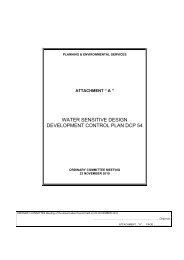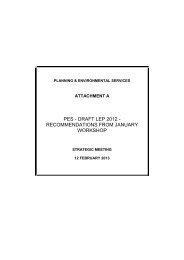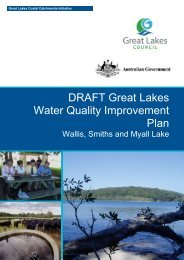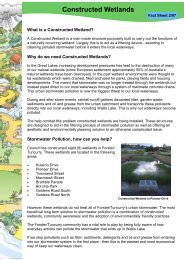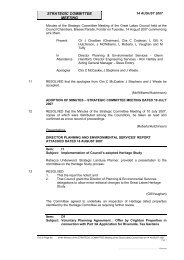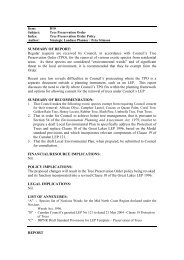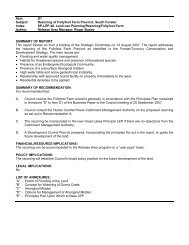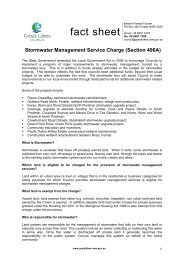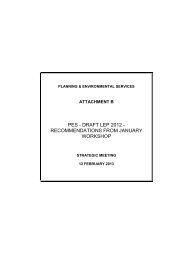smiths lake planning study volume 1: text - Great Lakes Council
smiths lake planning study volume 1: text - Great Lakes Council
smiths lake planning study volume 1: text - Great Lakes Council
Create successful ePaper yourself
Turn your PDF publications into a flip-book with our unique Google optimized e-Paper software.
SOILS AND GEOTECHNICAL 6<br />
Results are presented on the following figures:<br />
• Terrain Classification (Figure 2-1) showing the inferred distribution of terrain units,<br />
• Slope Stability and Acid Sulphate Soil Zonation Plans (Figure 2-2) assessing the risk of<br />
slope instability and acid sulphate soil occurrence, and<br />
• Test bores and sample locations together with regional geological boundaries (Figure 2-3).<br />
2.3 Physical Characteristics<br />
2.3.1 Topography<br />
The topography across the <strong>study</strong> area is variable and comprises:<br />
• Moderate to steep hillside areas with elevations up to 220m AHD. Surface slopes are<br />
generally concave in profile with steep upper hillside slopes up to 50% usually decreasing to<br />
10% to 25% across footslope areas. The hillside areas occur as a series of north-west /<br />
south-east striking ridgelines separated by broad drainage paths. The alignment of the<br />
ridgelines coincides with the regional bedding strike of the geological units. Geological<br />
structure appears to have had a strong influence on the region’s topography. These areas are<br />
characterised by rock outcrop and shallow residual soils that have weathered in place from<br />
the underlying rock.<br />
• Broad gently sloping drainage paths along the valley floor areas between the ridgelines<br />
(Wamwarra, Tarbuck, Jacks and Wallis Creeks). The drainage paths follow the same<br />
general alignment (north-west, south-east) as the ridgelines. These areas are characterised<br />
by deep soil profiles comprising soils that have weathered in place, been washed off<br />
surrounding hillside areas or accumulated as alluvium along the drainage paths.<br />
• Low lying areas with surface elevation less than 5m AHD that occur around the margin of<br />
Smiths Lake and the southern edge of Wallis Lake and are subject to estuarine influence.<br />
Past fluctuation in <strong>lake</strong> and sea level has resulted in periodic inundation of these areas with<br />
the deposition of sandy, muddy and organic estuarine sediment.<br />
• Coastal barrier sands and ridges in the Sandbar area. The coastal and wind blown (aeolian)<br />
sand deposits have formed sand dunes up to 47m AHD in elevation. Most of the sand dunes<br />
have gentle to moderate surface slopes of less than 25%, however there are some steep lee<br />
slopes with gradients in excess of 50%.<br />
2.3.2 Drainage<br />
Smiths Lake is a shallow, saline coastal lagoon that is protected from the ocean by a sand<br />
barrier that is occasionally opened to the sea by floods.<br />
Catchments in the <strong>study</strong> area discharges to Smiths Lake via Wamwarra and Tarbuck Creeks,<br />
with the larger catchment area of Ducks and Wallis Creek discharging to Wallis Lake. There<br />
are several creeks, but no major rivers draining into the <strong>lake</strong>.<br />
SMITHS_LAKE_PLANNING_STUDY.DOC<br />
O C E A N I C S<br />
A U S T R A L I A




